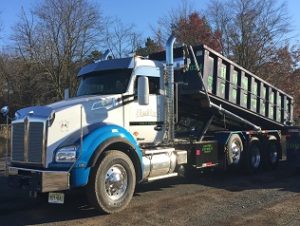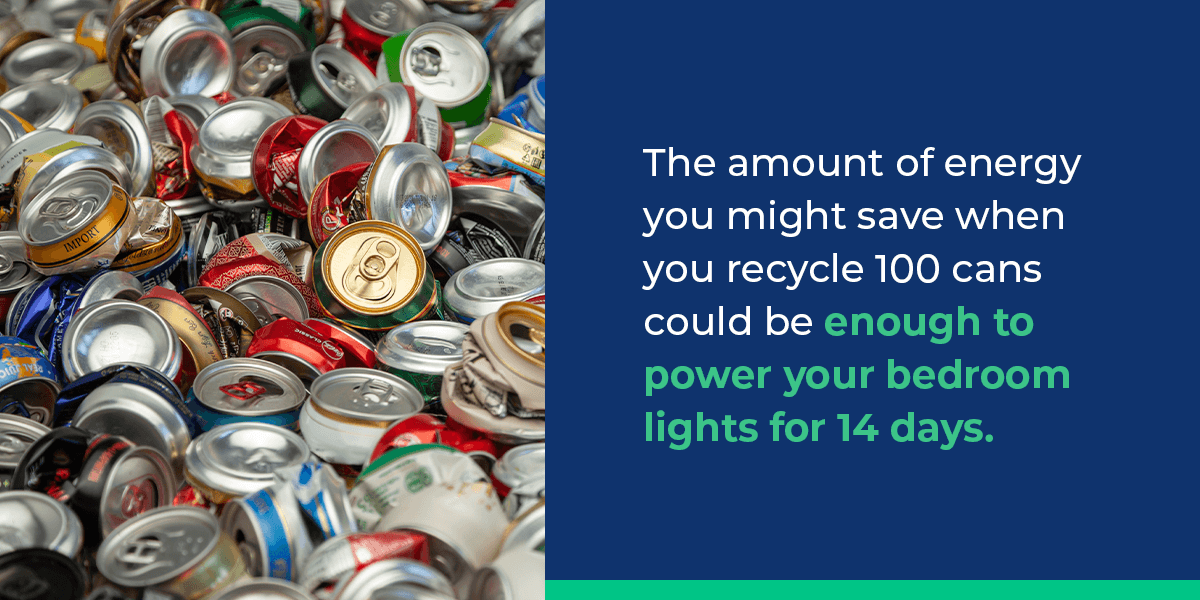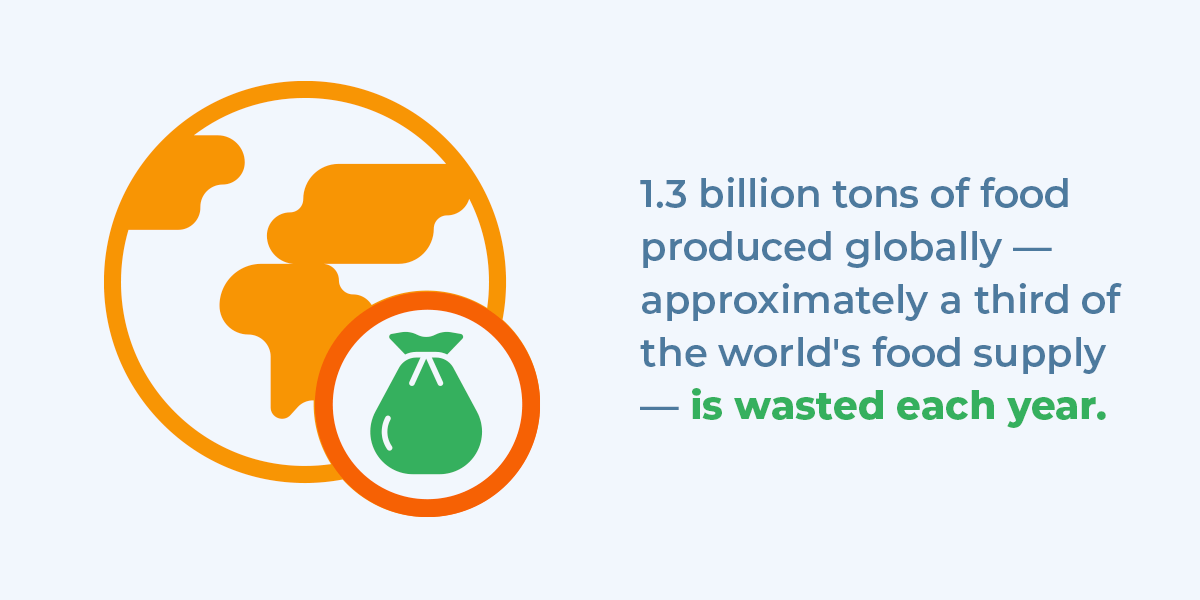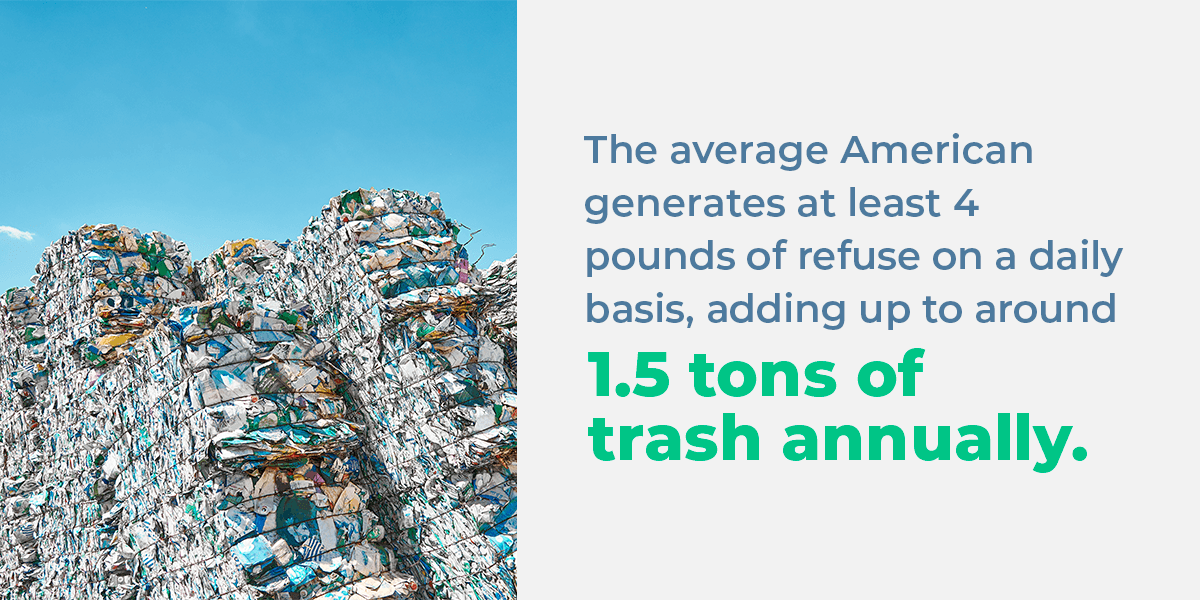Where Does Your Trash Go?

Most people dispose of items and perishable goods many times a day and put little thought into the process. Still, a person will sometimes wonder — where does trash end up? The fact is, trash could end up in one of many places, depending on how you choose to dispose of a given set of items. Recyclable trash, for example, is sorted and sent to a recycling center.
So what happens to trash after it’s thrown away? There are a number of possibilities:
- Most likely, the trash will end up in a landfill in your state. Landfills must be far away from cities for environmental reasons. Along the way, the trash stops at transfer stations and recycling facilities.
- In the best-case scenario, the trash will be incinerated, and the process this entails will generate the energy that feeds your local power grid.
- If you throw away electronic items, they might actually be sent to another nation.
Still, the question doesn’t end there because various steps must be employed to reduce trash and make it disappear in the most sanitary way possible. So, let’s find out where your trash goes and the journey it takes to get there.
WHERE DOES GARBAGE GO: RECYCLING CENTERS
First, let’s talk about recycling centers, where reusable household materials such as aluminum, glass, paper and plastic are melted down for reuse by manufacturers. The following items — and others — are left at the recycling center:
- Plastic drink containers
- Cereal boxes
- Soda bottles
- Newspapers and other paper products
- Milk cartons
- Tin cans
Most U.S. cities need to follow mandatory laws regarding recycling collection and center operation. You can read up on how your community or city handles recycling if you’re curious!
Recycling is one of the best measures Americans can take to help reduce CO2 emissions. According to DoSomething.org, the amount of energy you might save when you recycle 100 cans could be enough to power your bedroom lights for 14 days. Think about how much energy could be generated by all the thrown-away cans in a community!

While the benefits of recycling have been known since ancient civilizations, the modern-day practice of recycling has only been in place since the early 1980s. However, it only cuts into a small portion of annual waste amounts that could actually be recycled. Around 75% of all waste is recyclable, but only around 30% of waste produced in America is actually recycled. These figures are supported by DoSomething and the U.S. Environmental Protection Agency (EPA).
On November 15, 1997, the nation celebrated its first holiday called America Recycles Day. The idea was presented at the National Recycling Coalition’s (NRC’s) Congress and immediately embraced to promote the positive impacts of recycling. In 2019, recycling rates reached about 32% and continued to climb as more consumers became aware of environmentally friendly practices.
As more people gain awareness of recycling, it’s essential to promote the versatile disposal guides available in each location. Individual counties follow standards based on proximity to recycling facilities, capabilities of processing machines and other factors.
For example, some communities prioritize single-stream recycling, which means you can put all of your bottles, cans, plastic containers and paper grades into one bin. Other locations may require putting containers, bottles and cans into a separate bucket from the paper grades.
Check your local guidelines to see standards you should follow so you can help reduce the contamination of materials and foster better quality control at facilities.
Aluminum, Glass, Paper and More: What Gets Recycled?
The total scrap value of landfilled aluminum cans in 2014 exceeded $600 million, according to DoSomething.org estimates. As such, the nation is sitting on a vast energy supply in the form of waste, as opposed to recycled, aluminum. Machines are used to sort through recyclable refuse from other waste at dumping sites. There’s still room to grow technology-wise, but the potential definitely exists for it to gradually pick up the slack of wasteful human habits.

According to DoSomething, glass recycling habits are still far from perfect:
- In 2009 alone, 9 million tons of glass were disposed of instead of recycled throughout the nation. This produced enough waste for two cross-country lines of tractor-trailers.
- Americans dispose of roughly 28 billion jars and bottles on an annual basis.
- Statistics show that recycling habits are better in states that provide incentives for the return of recyclable materials.
The problem with recycling is not necessarily down to a lack of options throughout this nation’s communities. As things currently stand, the vast majority of Americans, 87%, have nearby recycling programs for newspapers and containers.
When compared to other types of recycling, paper recycling shows the most impressive amount of change. Between 1990 and 2010, the recycling of paper rose by 89%. And in 2022, 93.6% of cardboard boxes were recycled, an upgrade from 2021’s numbers.
Where Your Trash Goes: Composters
Recycling centers and facilities provide a great service for the reuse of everyday materials, but what about disposable organic products? After all, people don’t eat all the food they buy. In fact, roughly 1.3 billion tons of food produced globally — approximately a third of the world’s food supply — is wasted each year.

The silver lining to this problem comes in the form of composting food scraps, which does for organic matter what recycling does for glass, paper, plastic and aluminum.
Composting facilities transform discarded foods and plants into energy supplies and fertilizers for municipal use. Uneaten food from restaurants and perished produce at stores can be put to good use as fertilizer for the next round of crops.
When looking at the produce aisle in any store, you can see how important composting really is. Some products will leave the shelves if they aren’t bought within half a week. If all these products were composted, it would do a lot of good for the environment.
A composting center will employ an anaerobic digester to transform food and plant materials into fertilizers:
- Organic contents are accepted from public recycling centers, as well as farms, restaurants and grocery stores.
- Digesters of this sort are also used for local grid energy production at community wastewater treatment facilities.
Essentially, wasted foods don’t really go to waste when you consider their other, nonedible uses.
Composting has also existed as a personal practice among many of America’s more environmentally conscious homeowners for quite some time. This involves collecting organic waste in plastic bags stored underneath the kitchen sink. The contents are then dumped in a specific open area in the backyard, which becomes a compost pile. The contents will then be allowed to sink into the soil, covered with soil or buried to reduce waste.
Granted, organic matter naturally decomposes, so the disposal of rotten tomatoes is a more benign habit than the waste dispensing of glass bottles that could easily be recycled. Nonetheless, composting is another process of green living that helps make the world more efficient, and it does make an environmental difference.
Making Your Own Compost as a Home Project
For those who want to compost their waste at home, all you need to do is place your scraps and materials near your bin outside in an open pile. Consider a compost tumbler or a homemade container made of wood pallets.
It’s best to keep your container outside and ensure it has access to rainwater. Remember to keep adding layers of grass clippings, twigs, broken branches, leaves, coffee grounds with filters, and scraps of fruit and vegetables. Do not compost greasy food, meat, food with soap residue, weeds with seeds or any plants with diseases.
To turn organic matter into compost faster, consider turning your pile with a pitchfork or aerator tool once or twice a week. You can then use the decomposed materials as mulch, soil conditioner or potting mix.
Limited Adoption of Composting
As things stand, the public at large still has a long way to go in terms of understanding the benefits of composting — the equivalent of recycling for organic matter. Currently, Americans generate food waste to the tune of 21.5 million tons per year, according to DoSomething. In terms of greenhouse gas reduction, the composting of all unused food would be the equivalent of removing 2 million cars from the nation’s roads.
Clearly, a lot can be gained by the widespread adoption of composting practices. Still, usage remains limited.
With present consumer habits, more than half of all garbage ends up at one of the nation’s more than 3,000 landfills. Prior to the 1976 passage of the Resources Conservation and Recovery Act, landfills were unrestrained, open-air, seagull-flocked dumps. Since the passage of that law, regulations have been in place that maintain sanitation protocols and refined waste streams at all of the nation’s landfills. Technologies have also been implemented to reduce the size of waste loads and turn such materials into energy.
Where Your Trash Goes: Waste-to-Energy Plants
The EPA reports that the average American generates at least 4 pounds of refuse on a daily basis, adding up to around 1.5 tons of trash annually. The U.S. still has one of the highest overall waste counts on the planet, even after more than 30 years of widespread recycling programs and composting practices.

Thankfully, some of that waste is converted to energy at waste-to-energy facilities and used for local power grids. The process is carried out during the period between the collection of garbage and bringing it to its ultimate resting place at a landfill. By the time garbage has been laid to rest, it’s often radically transformed through methods such as incineration, which reduces the bulk and makes it easier to bury, all the while generating energy in the process.
The first step, of course, involves the collection of garbage from dumpsters and neighborhood trash cans. Then, the trash usually goes to a transfer station. From there, it will most likely be sent to a landfill — around 52% of all garbage in America finds its way to a landfill.
What Happens at the Transfer Station?
A transfer station serves as the temporary holding ground for trash collected by area trucks on local garbage pickup routes. At transfer stations, waste, as well as recyclable materials, are accepted. Here’s how it works:
- All contents dumped at a transfer station will be held at said location for a short time, where materials are typically sorted for their final destination. Contents are then transported to either a landfill or incineration facility via big rig trucks.
- There are some transfer stations that are called material recovery facilities. Recyclables are sorted here using magnetic machinery. Recovery facilities also employ separation technology to sort ferrous from nonferrous metals. With robotic arms, machines can somewhat compensate for the lack of human responsibility when it comes to recycling.
- At landfills, incoming trash is dumped into an open cell, where the contents are then pressed down with compacting machines. This reduces considerable amounts of bulk from the trash and frees up space within the cell for further loads of incoming trash.
- Once a cell has been filled to capacity, the space is covered with soil and materials to prevent toxic contents from escaping to the surface. With subsequent incoming loads of trash, the whole process is repeated at another open cell.
An industrial incinerator is a massive furnace in which waste is burned to ash. Incinerators run at super-high temperatures powerful enough to reduce even the hardest contents. They are popularly used in densely populated regions to quickly eliminate a lot of waste. They dispose of around 13% of the United States’ municipal solid waste.
Once incineration has been completed, a given batch of waste content is reduced to merely a fraction of its original mass, which helps conserve landfill space. The process of incineration also functions as a heat and electricity generator for local grids.
For some communities, the process of turning waste into energy serves as the primary residential power supply. The gas generated by the Tajiguas landfill in Santa Barbara, California, for example, powers up to 3,000 local homes each day.

Where Your Trash Goes: Shipping Trash Overseas
It’s estimated that the world’s trash includes about 350 million tons of plastic annually. Around 2% of global waste gets traded overseas. The remaining 98% is handled domestically. This majority is recycled, sent to a landfill or incinerated. Regarding who trades the most pounds of garbage, Europe leads as the biggest exporter, with about 3.9 million tons sent to other countries annually.
Japan is the second largest exporter of pounds of trash each year, sending about 821,000 tons overseas. The U.S. comes in third place with 751,000 tons of waste transported abroad annually, with other significant exporters including Turkey and China.
The U.S. doesn’t incinerate or bury all of its nonrecyclable, inorganic waste. On the contrary, a lot of waste is shipped to places far away from American land. Altogether, about 68,000 shipping containers were exported from America to developing countries in 2018 because of the importers’ limited environmental guidelines and lower labor costs. Some of these locations included Senegal, Bangladesh, Ethiopia and Laos.
Generally, the practice of shipping trash overseas, as part of the global waste trade, is reserved for waste of the toxic variety. Consequently, the contents are made up of a large variety of items that we throw away due to space limitations.
The global waste trade involves the transportation of waste from one nation to another for the purpose of disposal. In some cases, recyclable contents are separated from refuse, which is then sent to landfills. Significant amounts of the contents in question are of a toxic, hazardous nature.
Since the majority of global waste is produced in the industrialized northern hemisphere, poorer nations are typically at the receiving end of the global waste trade.
Waste is typically shipped from European and North American nations to countries in Asia, Africa and South America. China and Ghana are among the most frequent destinations for electronic waste — also known as “e-waste.” In China, scrap dealers regularly scavenge incoming shipments for products to recycle or resell, risking toxic exposure in the process.
Proponents of the global waste trade have argued it allows poorer countries to improve their economic standing. Critics of the practice allege countries on the receiving end are at risk of toxic pollution. Nations with a high intake of foreign waste have experienced disproportionate levels of contamination and illness among local populations.
E-Waste and Changes in Global Waste Disposal
The global waste trade has ballooned with the advent of modern technology, with products such as computers, peripherals, hardware, and other electronics comprising the bulk of global waste shipments. With the falling prices and built-in obsolescence of many of today’s electronic devices, overseas shipments of e-waste continue to grow in volume.
The global waste trade has come under fire by environmental groups, who cite the high levels of toxicity in and around the locations where contents are dumped on a routine basis. These dumpsites have witnessed drastic declines in nearby fish, bird, and assorted wildlife populations. The surrounding air, underlying soil, and nearby water at such locations have also shown high levels of toxicity.
The practice remains controversial yet unlikely to change in the foreseeable future. Data gathered by the EPA show that the average American household has 28 electronic devices. Another report by U.S. PIRG shows that America generates around 6.9 million tons of e-waste every year.
Some areas, such as New Jersey, have made it illegal to dispose of certain electronics in commercial and residential dumpsters. This is done in an effort to reduce toxic chemicals that might seep into the ground at landfills and affect the surrounding environment. Instead, locals can find their nearest e-waste collection point, as listed by the Department of Environmental Protection. Some cities and municipalities offer curbside recycling as a convenient way to reduce electronic waste.
NJ Dumpster Rentals from Hometown Waste & Recycling Services Inc.
Residents of New Jersey in Old Bridge can rest assured knowing Hometown Waste & Recycling Services Inc. will handle their trash properly. Our well-maintained fleets will always be there to clear your curb every week. We offer a $25 off deal for all our first-time customers.
As a family-owned business, we’ve built up a large, loyal customer base that we are proud to serve. Hometown Waste & Recycling Services Inc. provides live, on-call assistance to help anyone who has questions about what we offer. We are dedicated to giving you outstanding service and are always satisfied with our work. We’re also available on Saturdays and Sundays when most providers are unreachable.
We can help you with all your trash-related needs. Whether you need a garbage service or a 10 to 40-yard dumpster rental, we have your back. To learn more about what we can do for you, contact us today.


